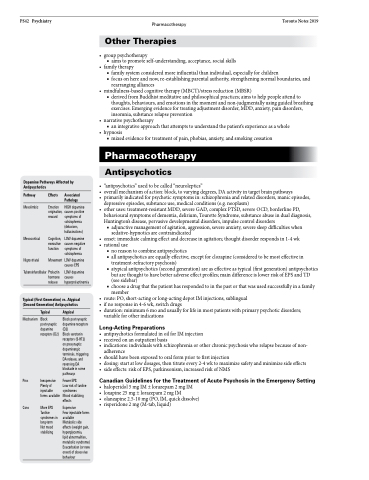Page 1206 - TNFlipTest
P. 1206
PS42 Psychiatry
Pharmacotherapy
Toronto Notes 2019
Dopamine Pathways Affected by Antipsychotics
Other Therapies
• grouppsychotherapy
■ aims to promote self-understanding, acceptance, social skills
• familytherapy
■ family system considered more influential than individual, especially for children
■ focus on here and now, re-establishing parental authority, strengthening normal boundaries, and
rearranging alliances
• mindfulness-basedcognitivetherapy(MBCT)/stressreduction(MBSR)
■ derived from Buddhist meditative and philosophical practices; aims to help people attend to thoughts, behaviours, and emotions in the moment and non-judgmentally using guided breathing exercises. Emerging evidence for treating adjustment disorder, MDD, anxiety, pain disorders, insomnia, substance relapse prevention
• narrativepsychotherapy
■ an integrative approach that attempts to understand the patient’s experience as a whole
• hypnosis
■ mixed evidence for treatment of pain, phobias, anxiety, and smoking cessation
Pharmacotherapy
Antipsychotics
• “antipsychotics”usedtobecalled“neuroleptics”
• overallmechanismofaction:block,tovaryingdegrees,DAactivityintargetbrainpathways
• primarilyindicatedforpsychoticsymptomsin:schizophreniaandrelateddisorders,manicepisodes,
depressive episodes, substance use, medical conditions (e.g. neoplasm)
• otheruses:treatment-resistantMDD,severeGAD,complexPTSD,severeOCD,borderlinePD,
behavioural symptoms of dementia, delirium, Tourette Syndrome, substance abuse in dual diagnosis, Huntington’s disease, pervasive developmental disorders, impulse control disorders
■ adjunctive management of agitation, aggression, severe anxiety, severe sleep difficulties when sedative-hypnotics are contraindicated
• onset: immediate calming effect and decrease in agitation; thought disorder responds in 1-4 wk • rationaluse
■ no reason to combine antipsychotics
■ all antipsychotics are equally effective, except for clozapine (considered to be most effective in
treatment-refractory psychosis)
■ atypical antipsychotics (second generation) are as effective as typical (first generation) antipsychotics
but are thought to have better adverse effect profiles; main difference is lower risk of EPS and TD
(see sidebar)
■ choose a drug that the patient has responded to in the past or that was used successfully in a family
member
• route:PO,short-actingorlong-actingdepotIMinjections,sublingual
• if no response in 4-6 wk, switch drugs
• duration:minimum6moandusuallyforlifeinmostpatientswithprimarypsychoticdisorders;
variable for other indications
Long-Acting Preparations
• antipsychotics formulated in oil for IM injection
• receivedonanoutpatientbasis
• indications:individualswithschizophreniaorotherchronicpsychosiswhorelapsebecauseofnon-
adherence
• should have been exposed to oral form prior to first injection
• dosing: start at low dosages, then titrate every 2-4 wk to maximize safety and minimize side effects • side effects: risk of EPS, parkinsonism, increased risk of NMS
Canadian Guidelines for the Treatment of Acute Psychosis in the Emergency Setting
• haloperidol5mgIM±lorazepam2mgIM
• loxapine25mg±lorazepam2mgIM
• olanzapine2.5-10mg(PO,IM,quickdissolve) • risperidone2mg(M-tab,liquid)
Pathway
Mesolimbic
Mesocortical
Nigrostriatal Tuberoinfundibular
Effects
Emotion origination, reward
Cognition, executive function
Movement
Prolactin hormone release
Associated Pathology
HIGH dopamine causespositive symptoms of schizophrenia (delusions, hallucinations)
LOW dopamine causes negative symptoms of schizophrenia
LOWdopamine causes EPS
LOWdopamine causes hyperprolactinemia
Typical (First Generation) vs. Atypical (Second Generation) Antipsychotics
Typical
Mechanism Block postsynaptic
dopamine receptors (D2)
Pros Inexpensive Plenty of
injectable forms available
Cons More EPS Tardive
syndromes in long-term Not mood stabilizing
Atypical
Block postsynaptic dopamine receptors (D2)
Block serotonin receptors (5-HT2) on presynaptic dopaminergic terminals, triggering DA release, and reversing DA blockade in some pathways
Fewer EPS
Low risk of tardive syndromes
Mood stabilizing effects
Expensive
Few injectable forms available
Metabolic side effects (weight gain, hyperglycemia,
lipid abnormalities, metabolic syndrome) Exacerbation (or new onset) of obsessive behaviour


